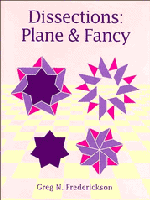Book contents
- Frontmatter
- Contents
- Preface
- 1 “Dat Pussle”
- 2 Our Geometric Universe
- 3 Fearful Symmetry
- 4 It's Hip to Be a Square
- 5 Triangles and Friends
- 6 All Polygons Created Equal
- 7 First Steps
- 8 Step Right Up!
- 9 Watch Your Step!
- 10 Just Tessellating
- 11 Plain Out-Stripped
- 12 Strips Teased
- 13 Tessellations Completed
- 14 Maltese Crosses
- 15 Curves Ahead
- 16 Stardom
- 17 Farewell, My Lindgren
- 18 The New Breed
- 19 When Polygons Aren't Regular
- 20 On to Solids
- 21 Cubes Rationalized
- 22 Prisms Reformed
- 23 Cheated, Bamboozled, and Hornswoggled
- 24 Solutions to All Our Problems
- Afterword
- Bibliography
- Index of Dissections
- General Index
1 - “Dat Pussle”
Published online by Cambridge University Press: 05 August 2012
- Frontmatter
- Contents
- Preface
- 1 “Dat Pussle”
- 2 Our Geometric Universe
- 3 Fearful Symmetry
- 4 It's Hip to Be a Square
- 5 Triangles and Friends
- 6 All Polygons Created Equal
- 7 First Steps
- 8 Step Right Up!
- 9 Watch Your Step!
- 10 Just Tessellating
- 11 Plain Out-Stripped
- 12 Strips Teased
- 13 Tessellations Completed
- 14 Maltese Crosses
- 15 Curves Ahead
- 16 Stardom
- 17 Farewell, My Lindgren
- 18 The New Breed
- 19 When Polygons Aren't Regular
- 20 On to Solids
- 21 Cubes Rationalized
- 22 Prisms Reformed
- 23 Cheated, Bamboozled, and Hornswoggled
- 24 Solutions to All Our Problems
- Afterword
- Bibliography
- Index of Dissections
- General Index
Summary
A small hand reaches up, and an eager smile appears: “I wanna-pay-wit dat pussle.” From the drawer indicated, the brown puzzle pieces are retrieved, then laid flat upon the carpet. The not-yet-three-year-old sets about his task with the words “I make a diamond.” The “diamond” is a regular heptagon, and the set makes a pair of heptagons, so the dad helps his son divide up the pieces and get started. With some coaching, the son forms first one, and then the other, of the heptagons. Finally, the dad takes his turn, assembling the whole set into a 7-pointed star, with a little help from his son. Repeated many times already, this activity has transcended puzzle into ritual – a ritual that echoes the dad's creation of the puzzle two decades earlier.
The puzzle in the preceding reminiscence was a physical model of the dissection shown in Figure 1.1. The two heptagons on the right are divided by line segments into nine pieces, which then rearrange to form the 7-pointed star on the left. A geometric dissection is a cutting of one or more figures into pieces that can be rearranged to form other figures. Since the constructions are precise, this activity falls within the realm of mathematics, though it is of a decidedly recreational flavor. This is a book devoted solely to such mathematical constructions.
- Type
- Chapter
- Information
- DissectionsPlane and Fancy, pp. 1 - 8Publisher: Cambridge University PressPrint publication year: 1997



